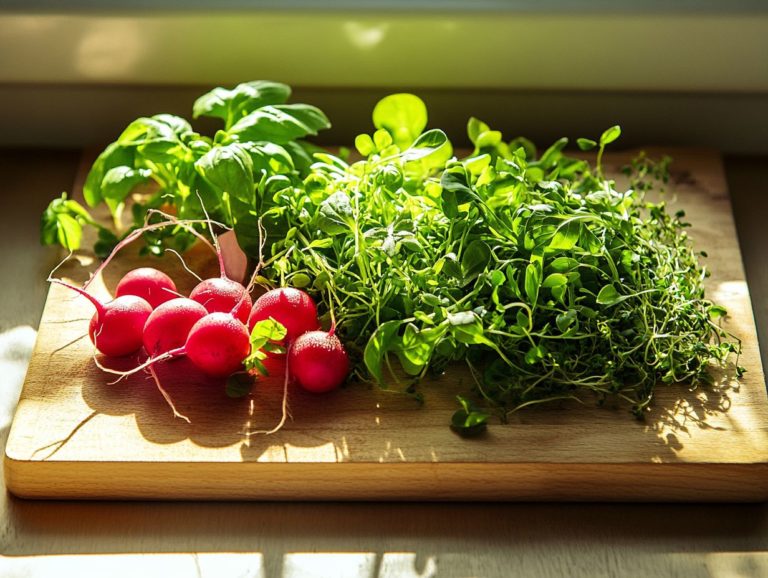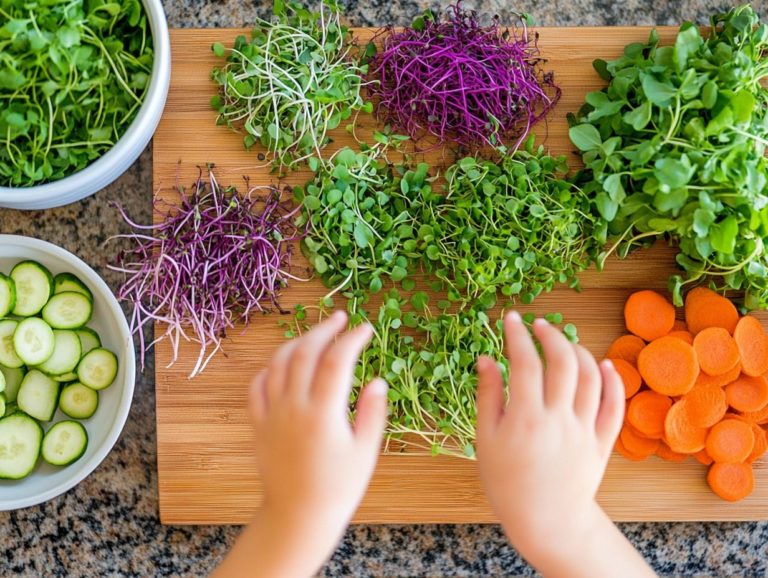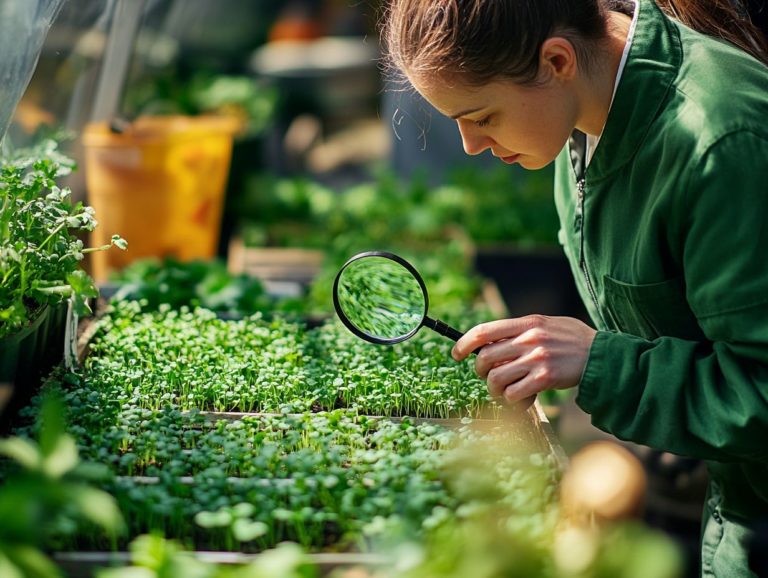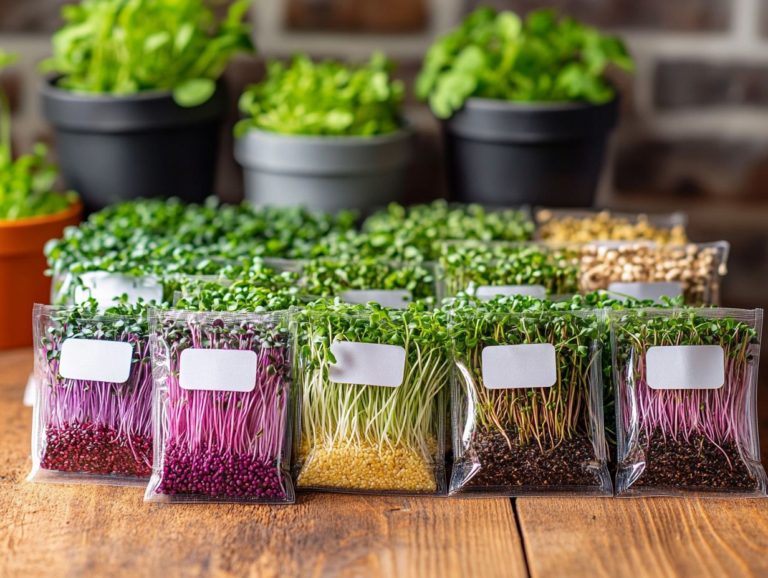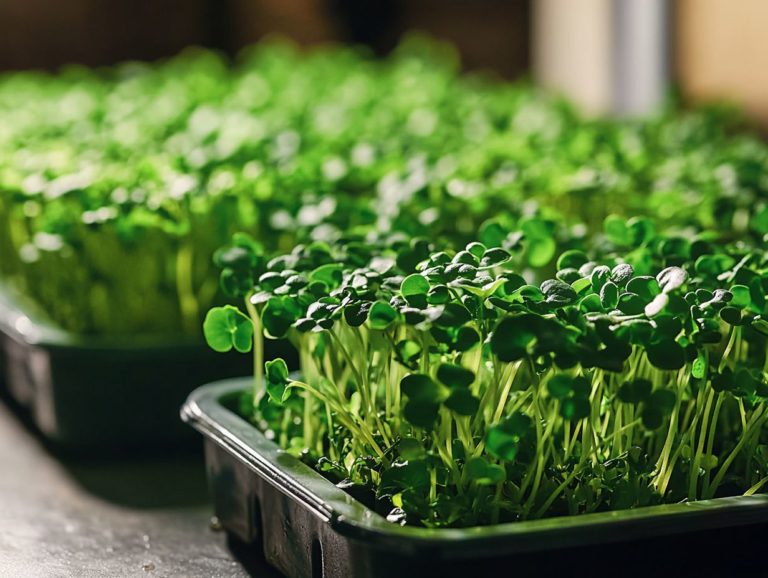How to Identify Edible Microgreens?
Microgreens are a nutrient-dense powerhouse.
They can enhance your meals and improve your health.
This article delves into what microgreens are.
It highlights their nutritional benefits and guides you on how to grow them.
Whether you re an experienced chef or an eager novice, you ll discover exciting ways to use microgreens!
Contents
Key Takeaways:

- Microgreens add flavor, texture, and nutrition.
- Identify edible microgreens for safety and health benefits.
- Growing your own microgreens is easy and cost-effective.
What are Microgreens?
Microgreens are young, edible plants you harvest at an early stage of growth, usually when the first true leaves have unfurled. You can grow them in water without soil or in soil, and they germinate quickly, making them a favorite for both home gardeners and culinary professionals.
These petite greens are celebrated for their bold flavors and vibrant hues. With a wide array of varieties to choose from, each brings its own unique taste and texture. Enjoy the peppery notes of arugula microgreens or the spicy kick of radish microgreens; these greens are versatile and packed with nutrients.
Definition and Characteristics
Microgreens are the young plant seedlings you harvest just after the first true leaves appear, showcasing a vibrant spectrum of colors and flavors.
These tiny greens are not just a feast for the eyes; they pack an intense flavor profile and unique textures that can elevate your dishes and surprise your palate. Varieties like broccoli microgreens offer a mild, slightly peppery taste brimming with nutrients, while basil microgreens deliver a sweet, aromatic punch that enhances any culinary creation. For those looking to explore further, check out the top microgreen varieties for gourmet cooking.
With such a diverse range available, there’s a microgreen for every dish, be it salads, garnishes, or smoothies. For more insights, check out microgreen varieties: what you need to know. Their ability to thrive in small spaces makes them a beloved choice among home gardeners and chefs alike.
Benefits of Eating Microgreens
Incorporating microgreens into your daily diet offers a multitude of benefits, elevating your nutritional intake while adding a delightful burst of flavor to your meals. These petite greens are more than just a garnish; they are brimming with vitamins, minerals, and antioxidants, making them a true powerhouse of nutrition.
Research indicates that microgreens can boast higher nutrient levels than their fully grown counterparts. Varieties such as radish and broccoli microgreens stand out for their exceptional health benefits. You can effortlessly enhance salads, sandwiches, and various dishes with these vibrant greens. For some inspiration, check out these must-try microgreen varieties for salads, transforming your meals with both taste and texture.
Nutritional Value and Health Benefits

The nutritional value of microgreens is truly impressive; they often boast higher concentrations of nutrients compared to their more mature vegetable counterparts. Varieties like kale and spinach deliver a powerful punch of essential vitamins, including A, C, E, and K.
Vitamin A is critical for eye health, while vitamin C supports the immune system and enhances iron absorption. Vitamin E serves as a potent antioxidant, protecting your cells from damage, and vitamin K is vital for proper blood clotting and maintaining bone health.
The remarkable antioxidant properties of microgreens not only elevate your overall well-being but also add delightful flavor to your meals. Incorporating them into your diet is a savvy move for anyone seeking to boost their nutritional intake.
Identifying Edible Microgreens
Identifying edible microgreens is crucial for your safety. Not every variety is safe for consumption; some may even pose health risks.
Commonly enjoyed options like basil, radish, and pea microgreens are celebrated for their distinct flavors and various ways to use in cooking.
By learning to distinguish these edible varieties from non-edible ones, you can enhance your culinary experiences while ensuring they’re both enjoyable and safe.
Familiarizing yourself with their unique characteristics allows you to navigate the world of microgreens confidently.
Common Types of Edible Microgreens
Explore the diverse world of edible microgreens. Each one is a culinary gem that can elevate your dishes and delight your palate.
Take radish microgreens, for example. Their peppery flavor adds a refreshing crunch to sandwiches or salads. Then there s basil microgreens, which bring a sweet, slightly aromatic essence to pastas, pestos, and pizzas, infusing your dishes with a burst of herbal zest.
Broccoli microgreens are another fantastic option. Mild yet nutrient-packed, they are perfect for grain bowls or smoothies, providing both a subtle flavor and a boost of vitamins. For more ideas on how to incorporate these greens, check out this quick guide to common microgreen varieties. Each of these microgreen varieties adds character to your meals while offering health benefits.
How to Distinguish from Non-Edible Varieties
Distinguishing edible microgreens from non-edible varieties is essential for safety and enjoyment in your culinary adventures, as some plants can be toxic.
These petite greens, typically harvested shortly after germination, vary greatly in both appearance and flavor. Look for vibrant colors and healthy, lush leaves hallmarks of freshness.
In contrast, non-edible microgreens may show signs of yellowing or wilting, which can indicate potential toxicity.
Conducting taste tests is a savvy strategy; many edible microgreens delight with their pleasantly mild, spicy flavors, while non-edible relatives often leave a bitter or unpleasant aftertaste.
Your top priority should always be safety, so source seeds from reputable suppliers and avoid wild foraging, where misidentifications could lead to surprises.
Growing Your Own Microgreens
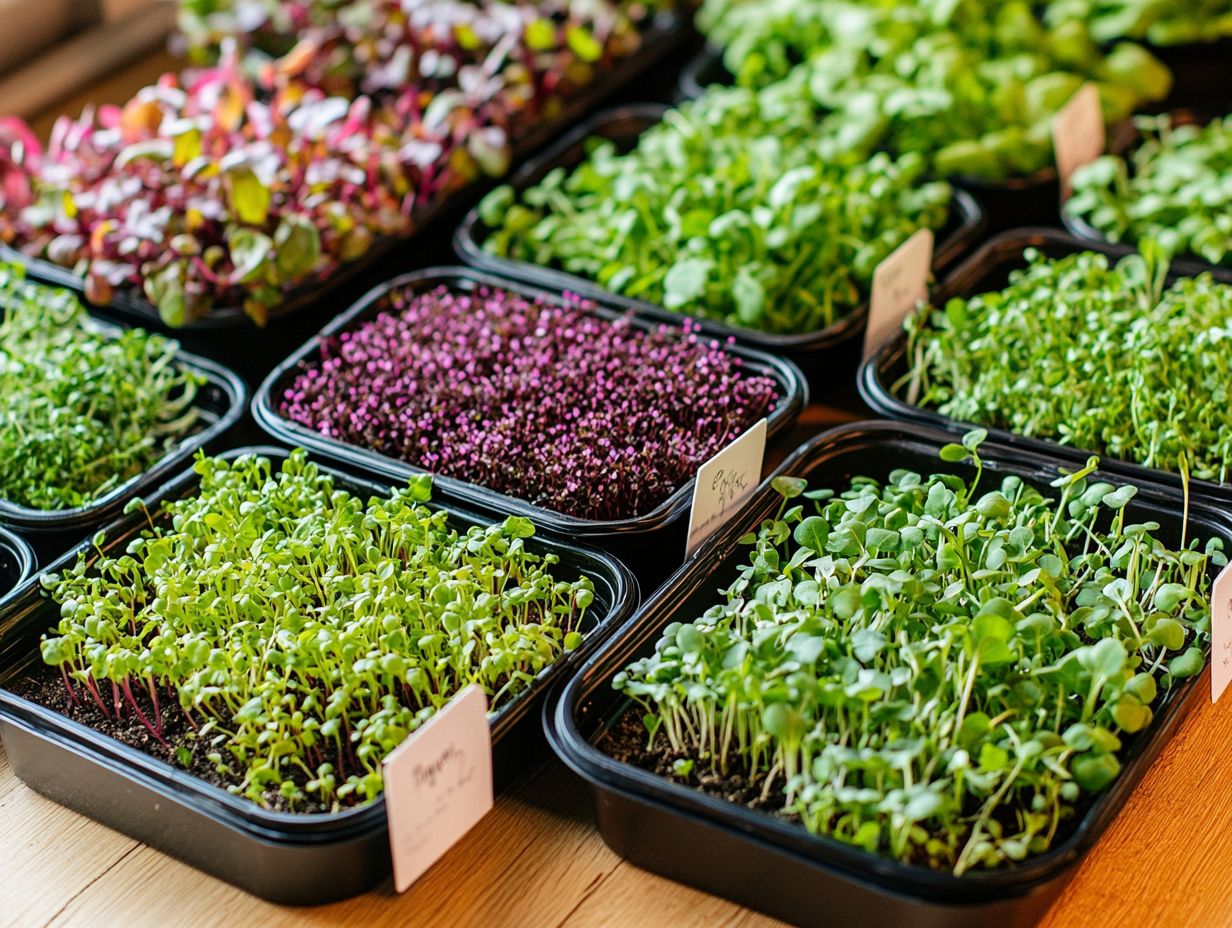
Cultivating your own microgreens is an effortless and fulfilling endeavor that requires minimal space and equipment, making it perfect for novice gardeners.
With just a handful of essential materials and simple steps, you can easily grow fresh, nutrient-rich microgreens at home. These quick-growing greens can thrive in soil or hydroponically, meaning in water without soil, and adapt beautifully to small containers or trays. Enjoy a harvest throughout the year!
Whether you prefer radish or basil microgreens, the journey is enjoyable and rewarding.
Materials and Steps for Cultivation
To successfully grow microgreens, gather a few essential materials and follow a clear, step-by-step approach.
Begin by collecting containers with drainage holes to allow excess water to escape and prevent root rot. An organic potting mix is the ideal growing medium, providing the necessary nutrients for thriving microgreens. You’ll also want high-quality seeds; popular choices include radish, basil, and sunflower.
For ease of care, consider using a spray bottle for gentle watering and ensure a light source whether natural sunlight or grow lights to enhance growth.
Now, let s explore the straightforward steps from sowing to harvest that will ensure your crop s success:
- Prepare your containers with drainage holes.
- Add organic potting mix.
- Sow high-quality seeds evenly across the surface.
- Lightly cover the seeds with more potting mix.
- Water gently using a spray bottle.
- Provide adequate light for growth.
- Harvest when ready!
Start your microgreens adventure today and discover the best microgreens for nutritional value to taste the difference!
Incorporating Microgreens into Your Diet
Incorporating microgreens into your diet offers a delightful opportunity to elevate your meals with an explosion of flavor, texture, and nutrition. These tiny greens can enhance many dishes and are a versatile staple in any kitchen.
Whether you want to elevate a simple salad with the aromatic notes of basil microgreens or add a zesty kick to a sandwich with radish microgreens, the culinary possibilities are truly endless. Their vibrant hues and bold flavors can transform everyday meals into extraordinary culinary experiences.
Recipe Ideas and Tips for Consumption
Microgreens can transform your meals, adding flavor and a wealth of nutrients to your dishes.
These tiny greens, brimming with zest, can effortlessly elevate a simple salad or become an exquisite layer in your delicious sandwich. When you add them to soups, they not only bring vibrant colors but also a refreshing crunch, making every spoonful a delightful experience.
Both chefs and home cooks are uncovering the remarkable versatility of microgreens, exploring a range of flavor pairings from zesty radish to sweet pea shoots. To unlock their full potential, it’s best to introduce these greens at the end of cooking or use them as a garnish. For those interested in different options, check out microgreen varieties: a guide for beginners, allowing their delicate flavors and impressive health benefits to truly shine in every bite.
Frequently Asked Questions
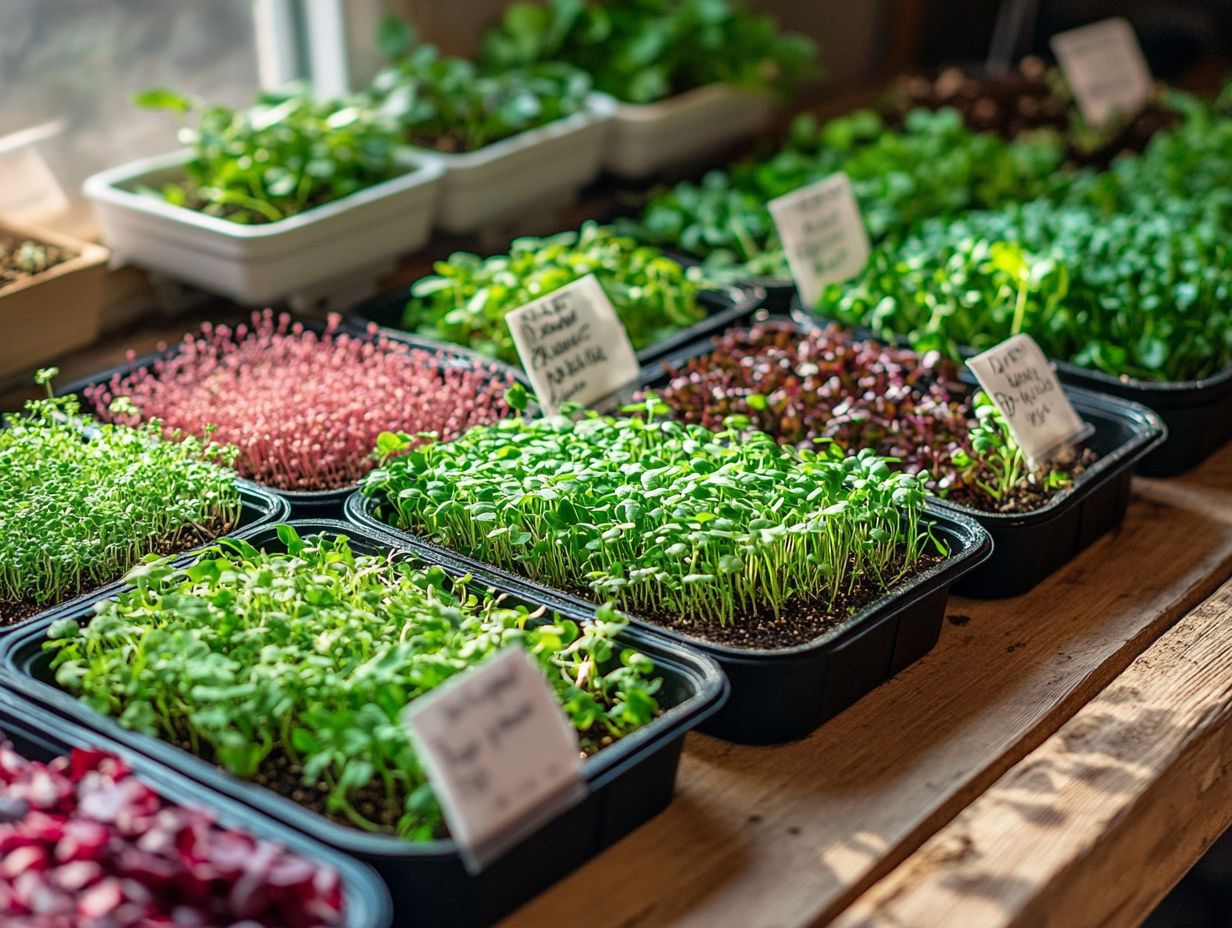
What are microgreens?
Microgreens are young, edible greens that are harvested just after the first set of true leaves appear. Cotyledon leaves are the first leaves that appear after a seed germinates, indicating the plant’s growth stage. They are smaller than baby greens but larger than sprouts.
Why are microgreens becoming more popular?
Microgreens are becoming more popular due to their high nutritional value and unique flavors. They are also easy to grow at home and add a pop of color and texture to dishes.
How can I identify edible microgreens?
The best way to identify edible microgreens is to look for their characteristic two cotyledon leaves, which are the first leaves to appear after germination. They may also have tiny true leaves that resemble the mature plant.
Can I eat all types of microgreens?
No, not all microgreens are edible. Some varieties, such as nightshade and tomato, are toxic to consume. It is important to research and only consume microgreens that are safe to eat.
What should I look for when buying microgreens?
When buying microgreens, look for clean and crisp leaves with vibrant colors. Avoid any with signs of wilting or mold. Also, make sure they are labeled as edible and grown in a safe, organic environment.
Can I grow my own microgreens?
Yes! Microgreens are easy and fun to grow at home. You can use seeds from various herbs, vegetables, and grains to grow your own microgreens. Just make sure to follow proper growing techniques and always use safe, organic materials.
Don t wait! Start adding these flavorful greens to your meals today!

